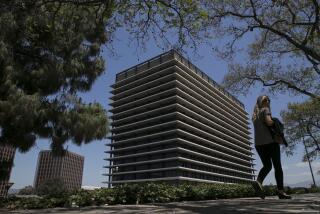L.A. OKs Water Rationing; More Cutbacks Likely
- Share via
Five years into a tenacious drought, the Los Angeles City Council on Tuesday imposed the toughest water rationing measures in the city’s history, and officials predicted that even more stringent measures may be necessary by the end of the year.
Beginning March 1, the city’s 3.5 million residents will have to cut water use by 10% from 1986 levels and, on May 1, by an additional 5%. Those who fail to comply face stiff penalties.
“I don’t think we can wait,” said Councilwoman Joan Milke Flores. “We are in a desperate situation and we must act accordingly.”
The 11-1 vote, with Councilman Nate Holden dissenting, came after nearly a year of debate over the need for rationing--a debate that was all but ended by the Metropolitan Water District’s recent order for its client cities to cut water consumption by 31%.
Los Angeles officials acknowledged that the rationing plan may not be tough enough.
Michael Gage, president of the Los Angeles Department of Water and Power Board of Commissioners, said the likelihood of deeper mandatory cuts this year is “very strong.” The DWP is preparing a contingency plan that would force Los Angeles residents and businesses to conserve as much as 50%, Gage said.
Even Flores, who was instrumental in killing Mayor Tom Bradley’s mandatory rationing proposal last year, said stronger conservation measures will probably be needed.
Bradley called the drought “truly a natural disaster” and applauded the council’s action. He said rationing will require all city residents to make “lifestyle changes,” from turning off faucets while brushing teeth to installing water conservation equipment.
The council was jolted into action by the MWD’s demand coupled with the release of data showing alarmingly low snowcap levels in the Sierra Nevada.
As a result of the findings, the DWP--which in normal years gets 70% of its water supply from the Eastern Sierra watershed--predicted that spring runoff will be 28% to 45% of normal.
In 1977, the only other time rationing was imposed in Los Angeles, the runoff was 42% of normal. Rationing was rescinded after seven months with the coming of heavy rains.
With no such relief in sight this year, the council on Tuesday began considering a controversial proposal to conserve water by limiting new water hookups, an action that would dramatically limit growth.
“This is only the beginning,” said Councilman Zev Yaroslavsky, who is pushing the water hookup measure. “We have too little water and too much demand and we’re going to have to stretch it out. We’re going to have to make some tough decisions.”
The city attorney was instructed to begin drafting an ordinance that would trim new hookups by twice the percentage of any mandatory water cutbacks that are imposed on Los Angeles residents. For instance, if 10% cutbacks in water use are imposed, hookups for new developments would be cut back by 20%.
Another measure that would limit and set priorities for new hookups has been proposed by Councilwoman Ruth Galanter. Both measures must go through council committees and are far from passage.
The council unanimously approved another controversial measure Tuesday that will permit owners of 480,000 rent-controlled apartments to pass on to tenants 50% of penalties imposed under the rationing program.
The measure is intended to force landlords and tenants to conserve, said Barbara Zeidman, director of the city’s rent stabilization division. Because most buildings have only a central water meter, penalties will be divided equally among all tenants, regardless of whether they conserve water, she said.
Landlords will not be permitted to remove coin-operated washing machines as a way to limit water use.
Several landlords complained to the council that they have little control over tenants’ water use and therefore tenants should be assessed 100% of the penalties.
Larry Gross, executive director of the Coalition for Economic Survival, said the measure is unfair to tenants. “Tenants may be trying all they can to conserve water and the landlord refuses to make repairs,” Gross said.
Only the landlord has the right to appeal the penalties in a proceeding before the DWP, Gross said, adding that tenants should also be allowed to file appeals.
The 650,000 apartment units that were built after 1978 and do not fall under the rent stabilization law are not affected. In those cases, landlords may raise rents to cover the charges when leases are renegotiated, according to Deputy City Atty. John F. Haggerty.
In voting against rationing, Holden said the measure contained an unfair surcharge that will apply to all DWP customers, including those who abide by the rationing requirements.
The council approved a DWP surcharge of 9 cents per billing unit, but put off action on a request to raise the amount to 15 cents. A billing unit is 748 gallons.
DWP officials said the surcharge is needed to offset a $40-million drop in revenue likely to result when customers begin conserving water under the rationing plan. It costs the DWP a fixed amount to transport water through its aqueduct system, regardless of the amount of water, officials said.
Even with a 15-cent surcharge--about 1 cent for 50 gallons of water--customers who conserve the required amount of water should receive lower bills, DWP officials said.
Under the terms of the rationing plan, DWP customers who fail to conserve the required amount of water will be charged 15% of their total bills plus $3 for each billing unit over the amount allowed. Fines escalate for repeated offenses and violations could lead to installation of flow restrictors and cutoff of service.
The DWP expects about 100,000 formal appeals from among its 650,000 customers, who will be allowed to contest water restrictions only after penalties have been assessed.
Beginning the first week in March, customers will be notified on their bimonthly DWP bills of the amount they must conserve. Any overuse in one billing period can be made up in the following period to avoid a penalty.
Because the DWP bills customers in phases over six weeks, some customers will not be notified of their rationing limits until mid-April and will not be required to abide by the restrictions until then.
WATER RATIONING PLAN HIGHLIGHTS
Key elements of the water rationing measures approved by the Los Angeles City Council on Tuesday. * Takes effect: March 1.
* Cutbacks required: 10% beginning March 1 and 15% beginning May 1, based on 1986 consumption levels for the dwelling. Water used by industry in the manufacturing process must be cut back by only 10%.
* Billing cycles: Customers will have two billing cycles, or four months, in which to meet their goal. Customers are not required to cut back until they receive their first bill, which could come as late as mid-April. Goals not met in one billing cycle can be made up in the following cycle without penalty.
* Penalty for first violation: $3 per billing unit of excess use, plus 15% of total water bill. A billing unit is 748 gallons.
* Penalty for second violation: $3 per excess billing unit, plus 25% of the bill.
* Penalty for third violation: $4 per excess billing unit, plus 75% of the bill.
* Penalties for chronic violations: After four violations, the DWP may install a flow restrictor on the water main for 48 hours. This device would reduce water flow from 56 gallons to 1 gallon per minute, meaning it would take a 1 1/2 minutes to flush a toilet. Further violations could result in total cutoff of water for 48 hours.
* Appeals: Homeowners, landlords and businesses may appeal for higher water quotas, but only after a penalty has been assessed.
* Apartments: Owners of rent-controlled apartments may charge tenants up to 50% of DWP penalties, spreading the charges evenly among all tenants.
More to Read
Sign up for Essential California
The most important California stories and recommendations in your inbox every morning.
You may occasionally receive promotional content from the Los Angeles Times.













